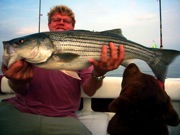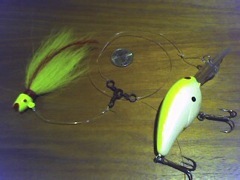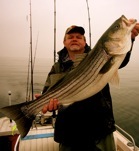 When the weather starts to warm, most Chesapeake Bay anglers have stored their umbrella rigs and stacked up their broomstick-sized tolling rods. The spring migration is long over and dreams of landing a trophy rockfish have faded. But don’t hang up those high hopes yet. There are still some nice fish around for anglers who are willing to downsize their gear and adjust their techniques.
When the weather starts to warm, most Chesapeake Bay anglers have stored their umbrella rigs and stacked up their broomstick-sized tolling rods. The spring migration is long over and dreams of landing a trophy rockfish have faded. But don’t hang up those high hopes yet. There are still some nice fish around for anglers who are willing to downsize their gear and adjust their techniques.
After forty plus years of freshwater fishing on TVA lakes in the Southeast, I moved to Maryland last year with visions of catching big rockfish. Through years of fishing for landlocked stripers in the lakes of the Tennessee River system, I had refined my techniques and felt relatively confident in my fishing ability. Nevertheless, I was a complete novice on saltwater and knew nothing about fishing techniques for the Chesapeake Bay.
My first Bay fishing experiences were in early summer of 2006 on charter boats out of Chesapeake Beach. I was surprised that we only caught 18 to 30-inch fish while trolling with huge rods and reels and giant lures. Though I find any kind of fishing interesting, it seemed unnecessary to use such heavy equipment for fish that size. When I asked why, I was told that this was the most productive method and there was still the chance to catch lingering spring trophy fish.
When I finally got my own boat in the water, I tried to employ the same techniques I had seen on the charter boats. I put away my freshwater tackle and spent hundreds of dollars on broomsticks, parachutes, and umbrella rigs. After a few weeks of fishing, I realized I just wasn’t enjoying using these rigs. To me, it just isn’t much fun to drag a fish through a swift boat wake with a heavy rod and 50-pound test line.
 After a few weeks of frustrated fishing, I decided to experiment. I dug out my freshwater tackle box, and dusted off my medium weight casting outfits spooled with 12-pound monofilament. I tied on some deep-running, fat-bodied crank-baits that I had used for largemouth bass, and set out for the ledge off Podickory Point. After locating a nice school of rockfish on my fish finder, I anchored up and started casting. After about a hundred casts to every direction, I realized that the fish were not biting. My arms were sore and I had nothing to show for two hours of hard cranking. To add insult to injury, a couple of other fisherman using heavy tackle were trolling bucktails with large weights and catching fish on nearly every pass.
After a few weeks of frustrated fishing, I decided to experiment. I dug out my freshwater tackle box, and dusted off my medium weight casting outfits spooled with 12-pound monofilament. I tied on some deep-running, fat-bodied crank-baits that I had used for largemouth bass, and set out for the ledge off Podickory Point. After locating a nice school of rockfish on my fish finder, I anchored up and started casting. After about a hundred casts to every direction, I realized that the fish were not biting. My arms were sore and I had nothing to show for two hours of hard cranking. To add insult to injury, a couple of other fisherman using heavy tackle were trolling bucktails with large weights and catching fish on nearly every pass.
A-ha! Those fishermen reminded me of one my father’s best techniques for catching rockfish on the lakes. I looked in my box and found a white, three quarter ounce bucktail. I tied it on about three feet above the crank-bait using a short leader and a three-way swivel. I dropped it off the back of the boat, checking first to make sure it was running true, and set off at a slow troll across the ledge.
The lip of the crank-bait had just started digging into the hard bottom when ” wham!” the rod went down and the drag started screaming. I bumped the boat motor into neutral and picked up my light outfit to feel the unmistakable slow head-shakes of a heavy rockfish. The fish ran straight away from the boat, peeling line off my drag so fast that I started worrying I might get spooled. He turned and dove just in time, and I was able to make up some ground, eventually fighting him to the side of the boat. He dove again, taking even more line. This was a real fight – just the kind of fishing I had been craving! After a few more heart-pounding minutes, I landed a fat 33-inch rockfish with my small bucktail firmly embedded in his lip.
 Thinking I might be on to something, I dropped the rig back over and resumed trolling. I was even more surprised when I doubled up on the next pass, catching two 30+ inch fish, one on the bucktail and the other on the crank-bait. Since that day, I’ve used this technique successfully many times, catching rockfish up to 45 inches long. The fish were consistently larger than the ones I had been catching with the umbrella rigs and parachutes, and they were certainly a lot more fun to fight on the light outfits!
Thinking I might be on to something, I dropped the rig back over and resumed trolling. I was even more surprised when I doubled up on the next pass, catching two 30+ inch fish, one on the bucktail and the other on the crank-bait. Since that day, I’ve used this technique successfully many times, catching rockfish up to 45 inches long. The fish were consistently larger than the ones I had been catching with the umbrella rigs and parachutes, and they were certainly a lot more fun to fight on the light outfits!
The crank-bait/bucktail tandem has become my go-to rig for summertime trolling. It also works very well in the fall when the fish are holding closer to the bottom. Other fishermen who have tried this technique have reported good results. I’ve refined the setup so that I now use 15-pound test braided line and a 25-pound fluorocarbon leader on both the bucktail and the plug. I sometimes tip the bucktail with a twister-tail or small piece of pork rind. I occasionally “tune” the crank-bait by adjusting the line attachment eye or bending the lip a little. It is extremely important that the plug run straight and true, especially when trolling with multiple rods. This method works best when fish are feeding near the bottom in water between 15 and 25 feet deep the typical summer pattern, but it will be effective at all times of the year. It is especially productive on and around oyster beds. So, bring out your smaller outfits, downsize your lures, and hang on for some hot light-tackle action!




I read your article on light tackle trolling and here is the result on the first try – a double hook-up with a 31″ striper on the crank bait and a 26″ on the bucktail, 19 lbs. of fish. WOW! It makes it hard to go back to work though. Thanks for all of the great info on your site.
Amazing. I just tried this today for the first time and caught a half-dozen big fish in the first hour within a mile of the ramp with only four rods. THANKS!
Josh Powell…
[…]A New Look at Light Tackle Trolling | Chesapeake Light Tackle[…]…
Dentist in Edison…
[…]A New Look at Light Tackle Trolling | Chesapeake Light Tackle[…]…
Shawn,
Does your book discuss light tackle trolling methods?
thanks
Matt
No, it doesn’t, Matt, although this entry kicks off one of the chapters because it shows my evolution from trolling to jigging on the Chesapeake.
Hi Shawn,
So just to clarify, you tie the crankbait using a 6 foot flouro leader onto one loop of the 3-way swivel, and then tie a bucktail onto one of the other loops using a 3 foot fluoro leader. Correct?
Thanks
Matt
Does it matter what kind of crank bait? Will the crank bait bring the buck tail down into the strike zone or the buck tail bring the crank bait down?